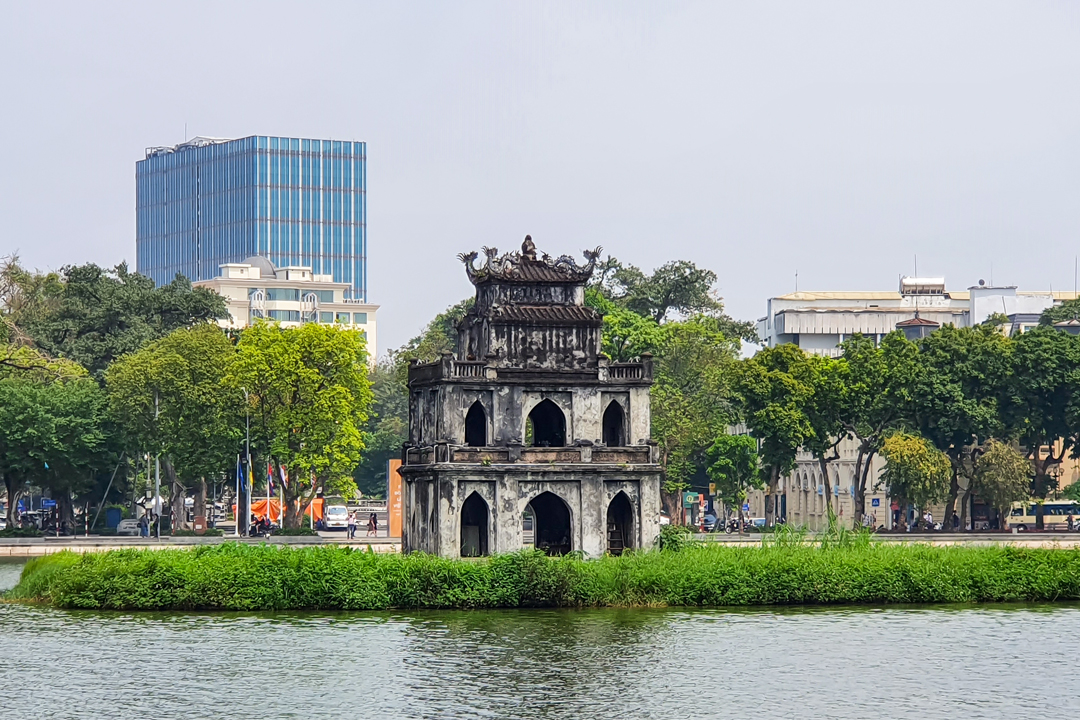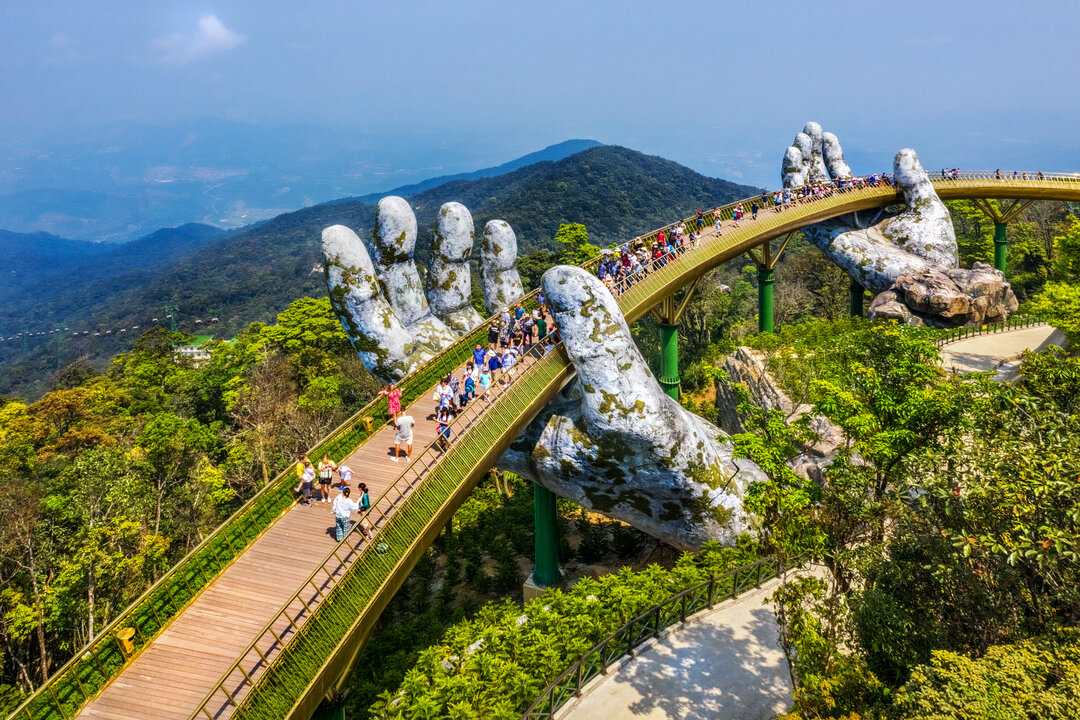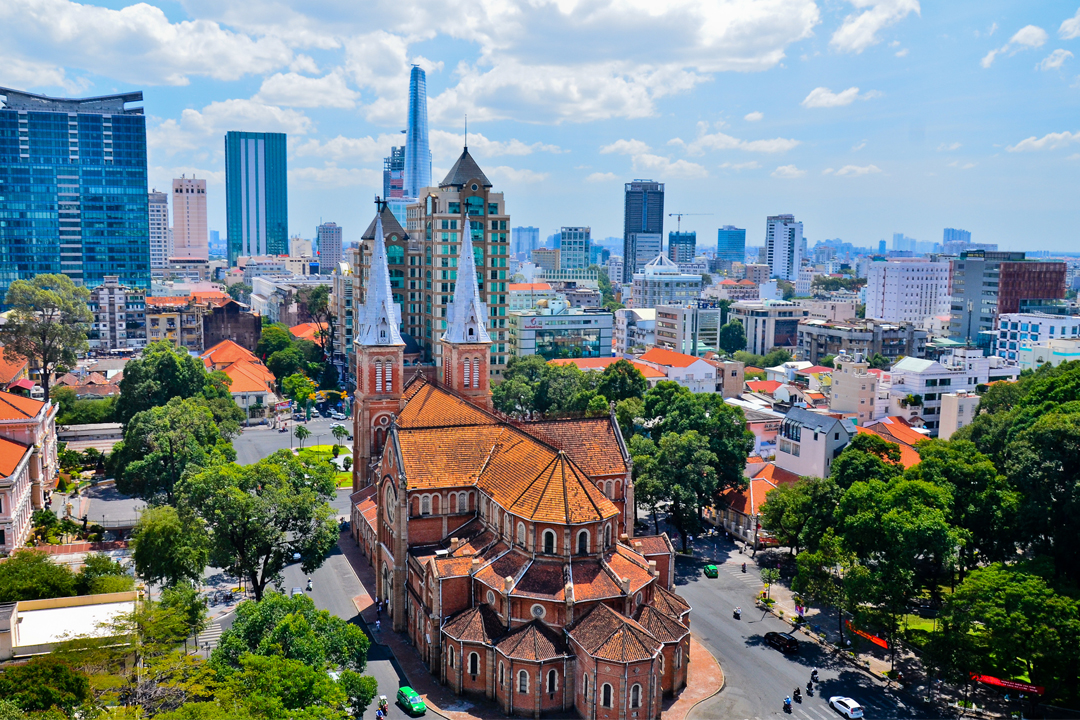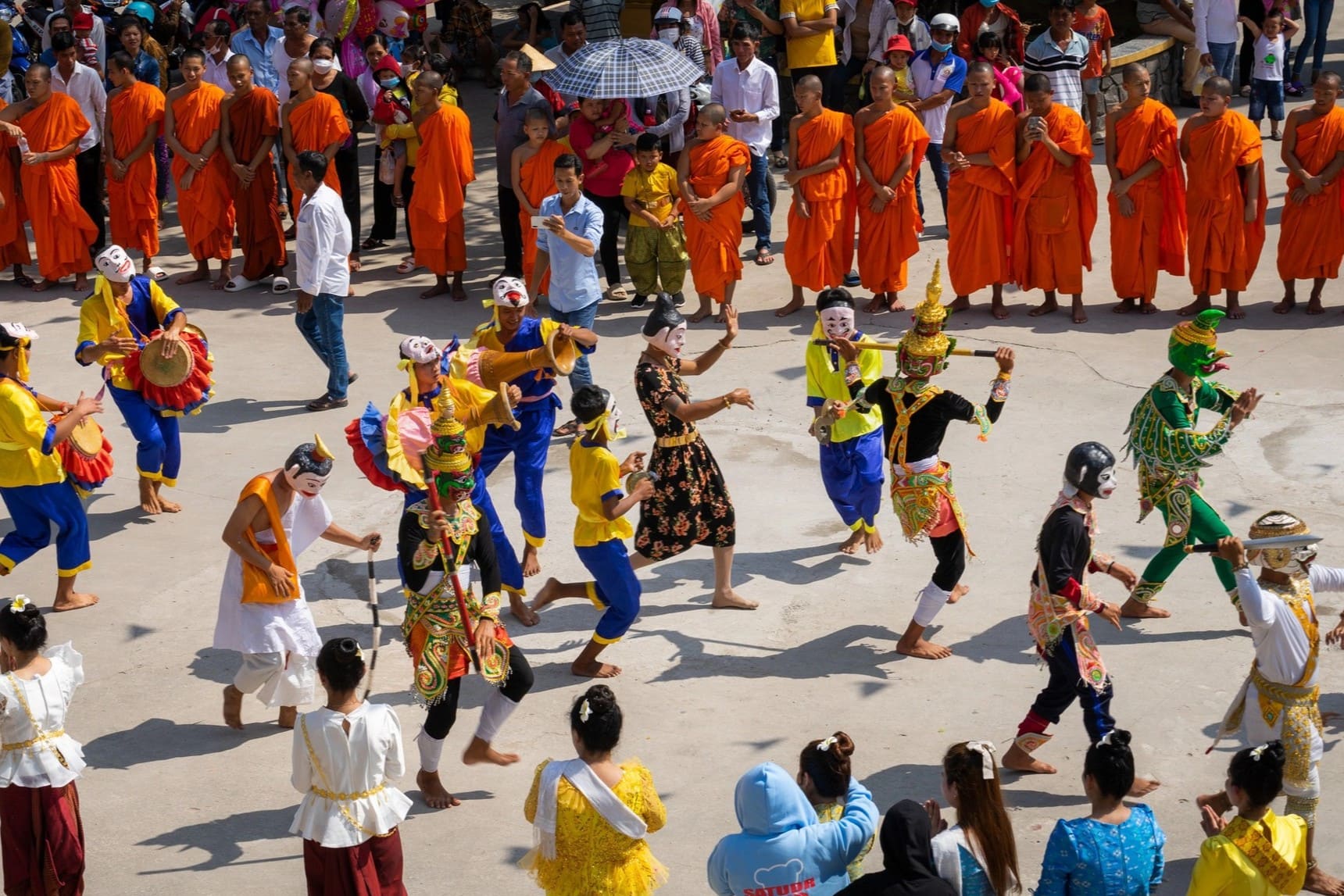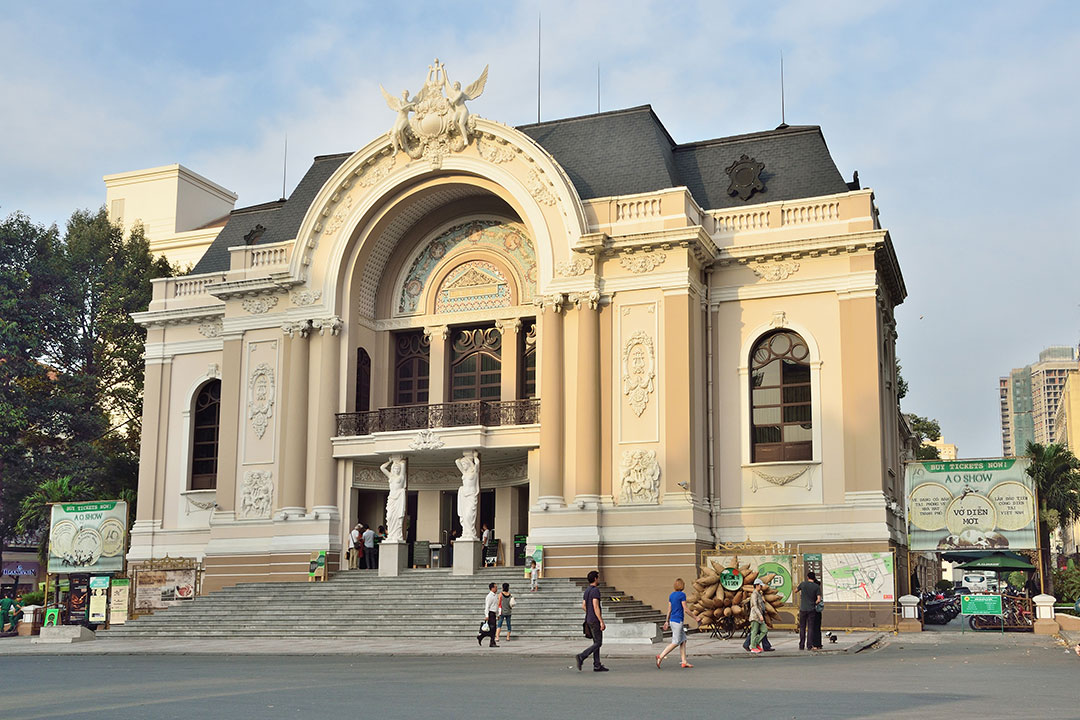Saigon Opera House: History, Architecture, Things To Do & Travel Guide
Saigon Opera House is one of the most iconic attractions in Ho Chi Minh City, where history and artistry converge in a stunning display of French colonial architecture. Built between 1898 and 1900, this cultural landmark stands as a beacon of artistic expression and historical significance. Today, it continues to host opera, ballet, and contemporary performances, offering travelers a glimpse into Vietnam’s vibrant cultural scene. With GTrip, you can experience the Saigon Opera House alongside other highlights that define the soul of Ho Chi Minh City.
Overview of Saigon Opera House
The Saigon Opera House, commonly known as the Ho Chi Minh City Opera House, is a remarkable symbol of Vietnam's colonial past and cultural evolution. Today, it continues to captivate visitors as both an architectural gem and a vibrant venue for world-class performances.
Where is Saigon Opera House?
Location: 7 Lam Son Square, Saigon Ward (formerly Ben Nghe Ward, District 1), Ho Chi Minh City
The Saigon Opera House commands a prime location in the very heart of Ho Chi Minh City, standing as a magnificent centerpiece at Lam Son Square. Its prestigious position places it at the epicenter of the city's colonial heritage, making it an unmissable landmark and an ideal starting point for exploring the historic core. This central location ensures it is surrounded by other key attractions, luxury hotels, and vibrant streets, making it incredibly convenient for visitors to access.
Opening hours and ticket prices of Ho Chi Minh City Opera House
Before planning your visit to the Ho Chi Minh City Opera House, it's important to be aware of its opening hours and ticket pricing. Here's what you need to know to make the most of your visit
Opening hours
The Saigon Opera House, also known as the Municipal Theatre, primarily opens its doors to the public during scheduled events and performances. Consequently, there are no fixed daily opening hours for general visits. However, the box office, located adjacent to the opera house, typically operates daily from 9:00 AM to 4:30 PM, allowing tourists to purchase tickets directly.
Ticket prices option
Ticket prices at the Saigon Opera House vary depending on the show, seating zone, and organizer. Below is a quick overview to help you grasp the main ranges:
- A O Show:
- Zone A (aah!): 800,000 VND (~$33)
- Zone O (ooh!): 1,250,000 VND (~$52)
- Zone W (wow!): 1,750,000 VND (~$72)
- Other events: 80,000 - 650,000 VND (~$3 - 27)
Note: Prices may change depending on the event and production company. For the most accurate and updated details, check the official website or contact the opera house box office directly.
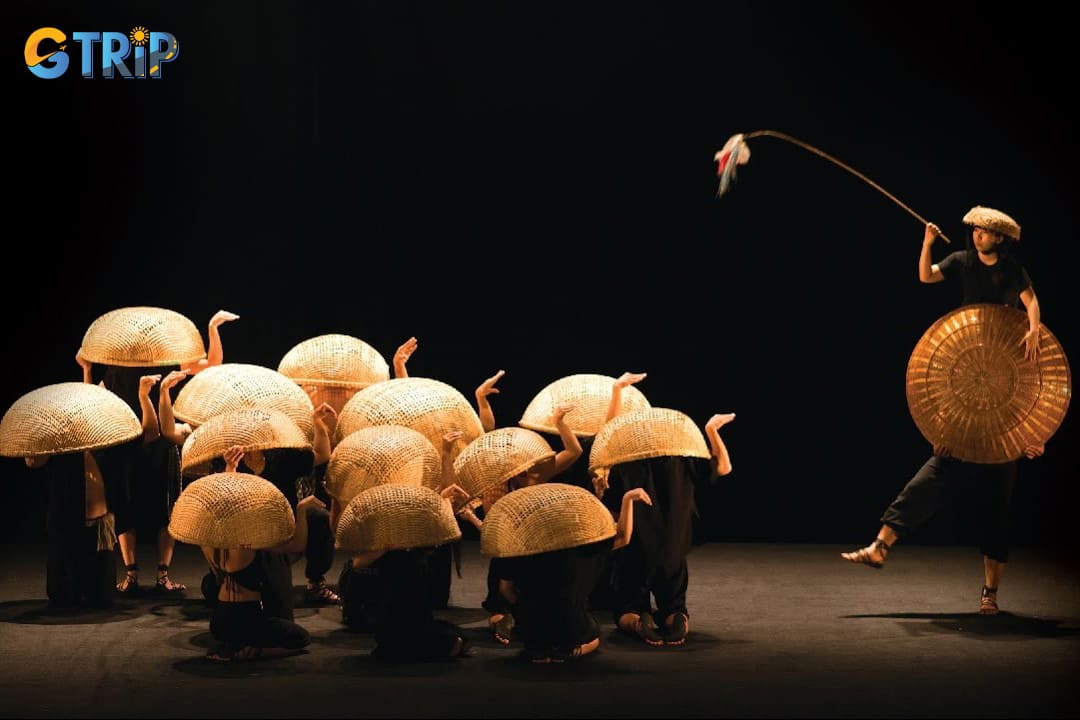
The renowned A O Show offers tickets starting from 800,000 VND
How to get to the Ho Chi Minh City Opera House?
Located in the heart of former District 1, the Ho Chi Minh City Opera House is easily accessible, with multiple transportation options making it convenient for visitors to reach this iconic landmark.
By metro
Using Ho Chi Minh City’s modern metro system is the most efficient and comfortable way to reach the Opera House, completely bypassing street-level traffic. The brand-new trains are clean, air-conditioned, and easy to navigate, ideal for both locals and tourists.
- Nearest metro stations: Ben Thanh Station (Line 1) and Opera House Station (Line 2, future)
- Walk from Ben Thanh Station: 5-10 minutes to Lam Son Square
- Ticket prices: 7,000 - 20,000 VND (around 0.30 - 1 USD) depending on distance
By public bus
Public buses provide an economical option for reaching the Opera House, ideal for travelers mindful of their budget. Several bus routes stop near Lam Son Square, with fares starting at just 7,000 VND (around $0.30). You can check Google Maps or the Moovit app for real-time bus schedules. Some key routes include:
- Bus 03 (Ben Thanh - Thanh Xuan)
- Bus 19 (Saigon Bus Station - Suoi Tien)
- Bus 45 (Ben Thanh - Hiep Phu)
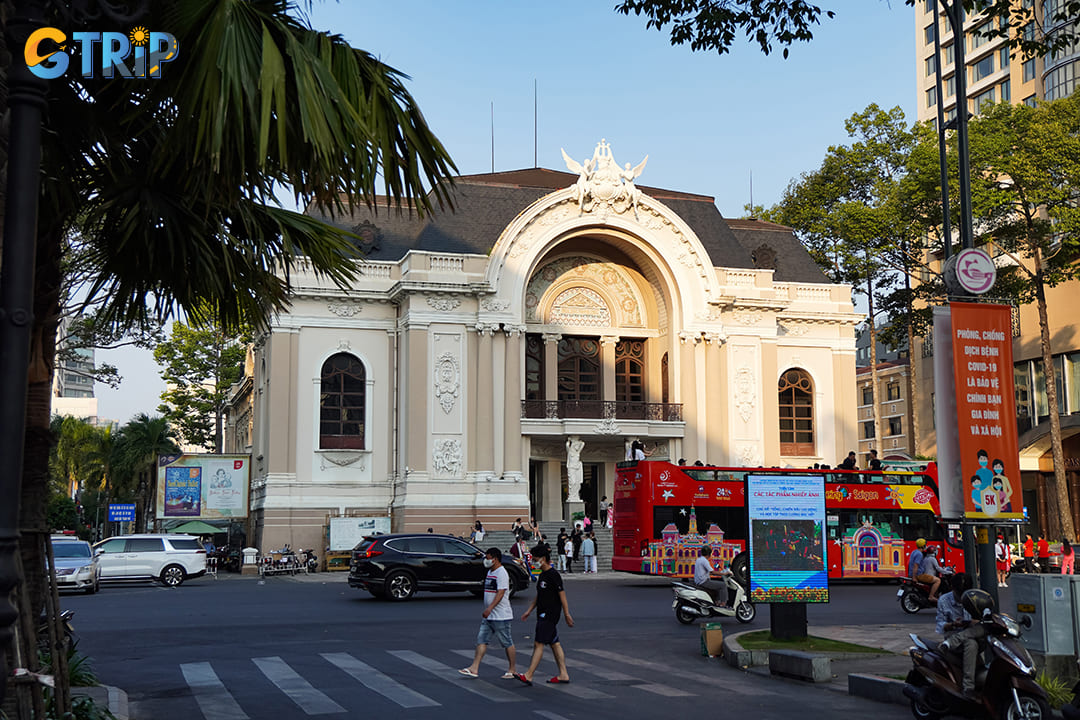
For budget-conscious travelers, public buses offer an affordable way to reach the opera house
By taxi or ride-hailing services
Taxis and ride-hailing services provide a comfortable and convenient way to reach the opera house.
- Taxi companies: Vinasun, Mai Linh (metered fares)
- Ride-hailing apps: Grab, Be, XanhSM
- From Tan Son Nhat International Airport: 30-40 minutes, 150,000 - 250,000 VND (around $6 - 10) depending on traffic
By motorbike or bicycle
Renting a motorbike or bicycle offers flexibility and freedom to explore the city.
- Motorbike: 100,000 - 200,000 VND/day (around $4 - 8)
- Bicycle: 50,000 - 150,000 VND/day (around $2 - 6)
- Secure parking near Dong Khoi Street: 5,000 - 10,000 VND (around $0.20 - 0.40)
By walking
For visitors staying in former District 1, the Opera House is easily reachable on foot.
- Pedestrian-friendly areas: Dong Khoi Street, Nguyen Hue Walking Street, Lam Son Square
- Scenic views: French colonial buildings, luxury hotels, and cultural landmarks
- Nearby hotels within a 5-10 minute walk: Park Hyatt Saigon, Caravelle Hotel
Tips:
- Avoid rush hours (7:00 - 9:00 AM and 4:30 - 7:00 PM) to prevent traffic delays.
- Check ride-hailing fares before booking to avoid price surges.
- If taking the bus, carry small cash for tickets, as change may not be available.
With these transportation options, you can easily access the Ho Chi Minh City Opera House and enjoy its cultural performances without hassle.
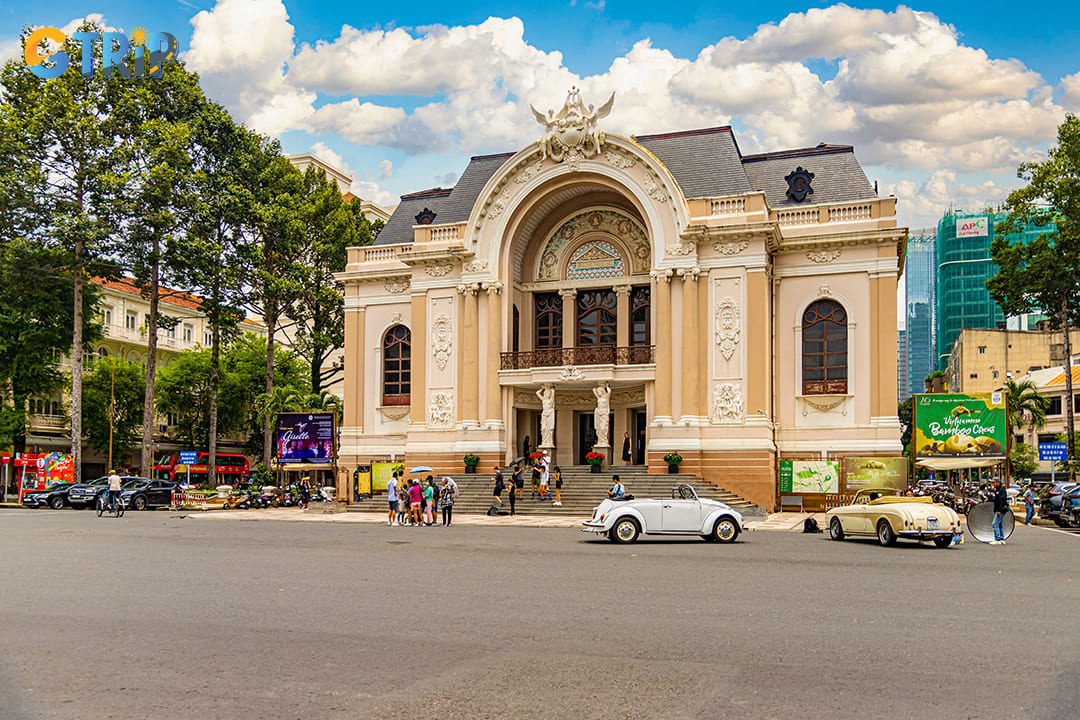
If staying in former District 1, walking to the opera house is a convenient choice
History of Saigon Opera House
The history of the Saigon Opera House reflects over a century of changes in Saigon, now Ho Chi Minh City, from shifts in governance to evolving art forms and national identity.
Origins and colonial era (1898 - 1945)
The construction of the Saigon Opera House was commissioned by the French colonial administration during a period when Vietnam was part of French Indochina. The aim was to establish a European-style cultural hub in Saigon, which was then a thriving colonial city. Designed by French architect Eugene Ferret, the building was influenced by the flamboyant architectural style of the French Third Republic. Its design was particularly inspired by the Petit Palais in Paris, completed in the same year.
Construction began in 1898, and the opera house was officially inaugurated on January 1, 1900. The structure was built with imported French materials like intricate carvings, grand chandeliers, and plush furnishings, reflecting the colonial aim to recreate a European ambiance in Southeast Asia. The opera house primarily hosted French operas, plays, and classical music performances, catering to the French elite and affluent Vietnamese audiences who were exposed to Western culture.
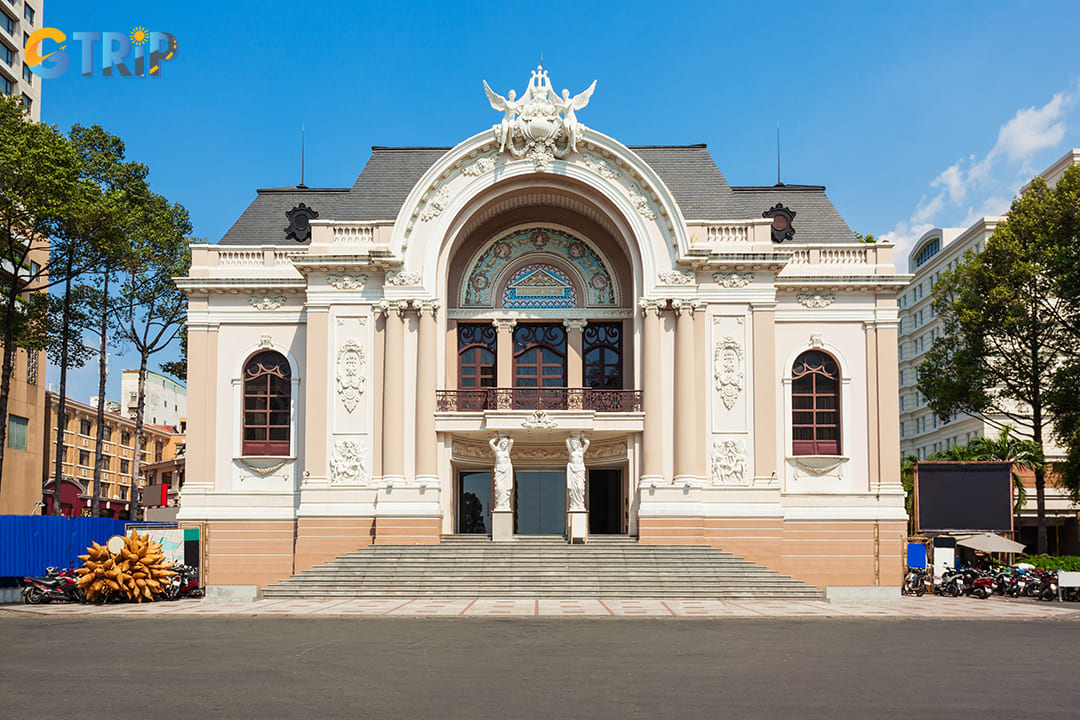
The building, crafted by French architect Eugene Ferret, reflects the ornate architectural style popular during the French Third Republic
Wartime transformations and post-colonial shifts (1945 - 1975)
Following the end of World War II and the gradual decline of French influence in Vietnam, the Saigon Opera House experienced significant shifts in its role and purpose. During the First Indochina War (1946 - 1954), its function as a cultural venue diminished as the city became a focal point of political and military conflict.
In the 1950s, under the newly established Republic of Vietnam, the opera house remained an important cultural landmark but saw reduced artistic activity. However, the Vietnam War (1955-1975) drastically altered its function. In 1956, the South Vietnamese government repurposed the building as the Lower House of the National Assembly, stripping it of its original artistic and cultural role. During this time, its grandeur was partially concealed by modifications made to suit its new governmental function.
Post-war restoration and revival (1975 - present)
With the reunification of Vietnam in 1975, the opera house entered another phase of transformation. For a brief period, it continued to serve governmental functions before being returned to its original role as a performance venue. However, decades of repurposing and neglect had taken a toll on the building's structural integrity and artistic appeal.
Recognizing its historical and cultural significance, the Vietnamese government launched extensive restoration efforts in 1995, to commemorate the 300th anniversary of Ho Chi Minh City. The renovation sought to restore the opera house to its original architectural grandeur while modernizing its facilities to accommodate contemporary performances. The project was completed in 1998, and the venue was officially reopened to the public, once again serving as a stage for local and international artists.
Today, the Ho Chi Minh City Opera House stands as a proud emblem of Vietnam's resilience and artistic heritage. It hosts a diverse array of performances, including traditional Vietnamese art forms, ballet, orchestral concerts, and international productions. The opera house remains a testament to the city's enduring cultural legacy, reflecting its journey from a colonial outpost to a modern metropolis while preserving its historical essence for future generations.
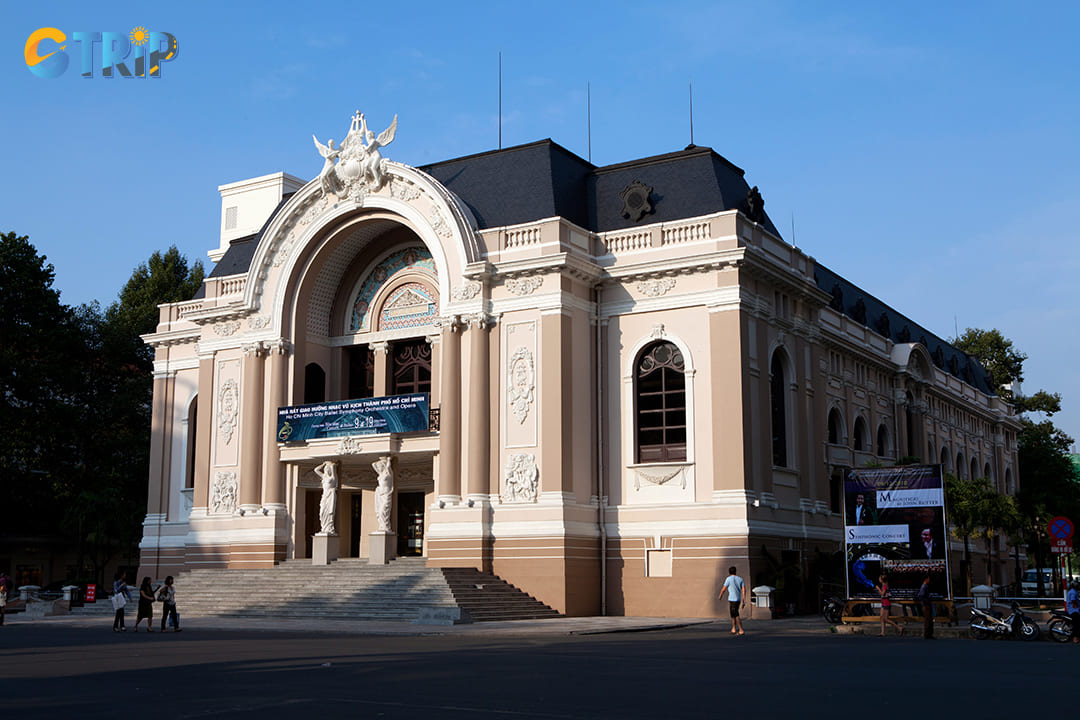
The Ho Chi Minh City Opera House serves as a striking symbol of Vietnam’s enduring spirit and rich artistic legacy
Architecture of Saigon Opera House
The Saigon Opera House stands as an architectural testimony to the grandeur of French colonial influence in Vietnam. Built between 1898 and 1900, this iconic structure serves as a cultural hub and also as a living artifact of historical and architectural significance.
French colonial architectural influence
The opera house was designed by French architect Eugène Ferret, drawing inspiration from the Petit Palais in Paris. The Beaux-Arts style, which was highly popular during the French Third Republic, is evident in its symmetrical layout, elaborate ornamentation, and grandiose scale. Key architectural features that define its French colonial style include:
- Ornate facade: The exterior is adorned with intricate bas-reliefs, sculpted motifs, and decorative stonework, reflecting the grandeur typical of French civic buildings of the era.
- Grand archways and columns: The opera house features prominent arched entrances framed by Corinthian columns, emphasizing a sense of classical elegance and structural harmony.
- Sculptural decorations: The front of the building is embellished with statues and reliefs depicting mythical figures, a common feature in Beaux-Arts architecture.
- Balustrades and wrought iron detailing: The upper levels incorporate ornamental balustrades and intricate wrought ironwork, enhancing both visual appeal and architectural depth.
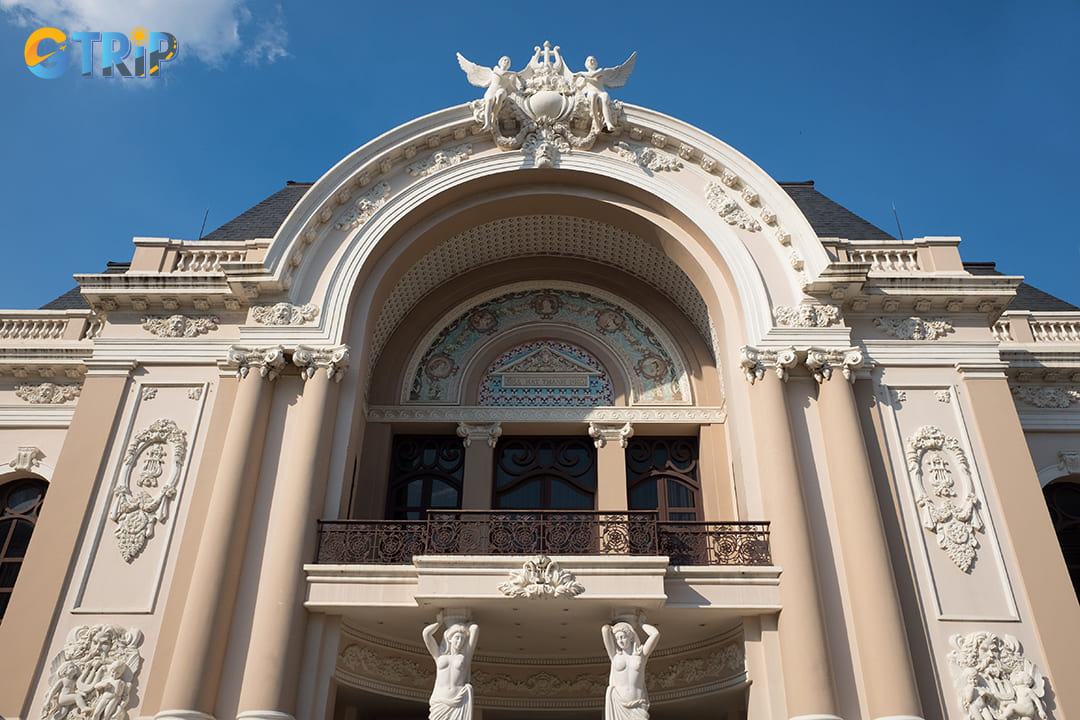
The facade features detailed bas-reliefs, sculpted designs, and ornate stone decorations
Interior design and functional features
The interior of the opera house is as impressive as its exterior, designed to provide an immersive artistic experience while maintaining acoustic excellence. Some of its most striking features include:
- Grand auditorium: The main hall accommodates approximately 500 guests, with a horseshoe-shaped seating arrangement that optimizes acoustics and visibility.
- Opulent ceiling frescoes and chandeliers: The ceilings are adorned with elaborate frescoes, adding to the luxurious ambiance, while large chandeliers provide warm, diffused lighting.
- Marble staircase and sculpted decorations: A grand central staircase, made of imported marble, leads to the upper levels, flanked by intricately sculpted balustrades and decorative elements.
- Superior acoustics: The opera house was constructed with materials and design techniques that enhance sound projection, ensuring that performances retain clarity and richness.
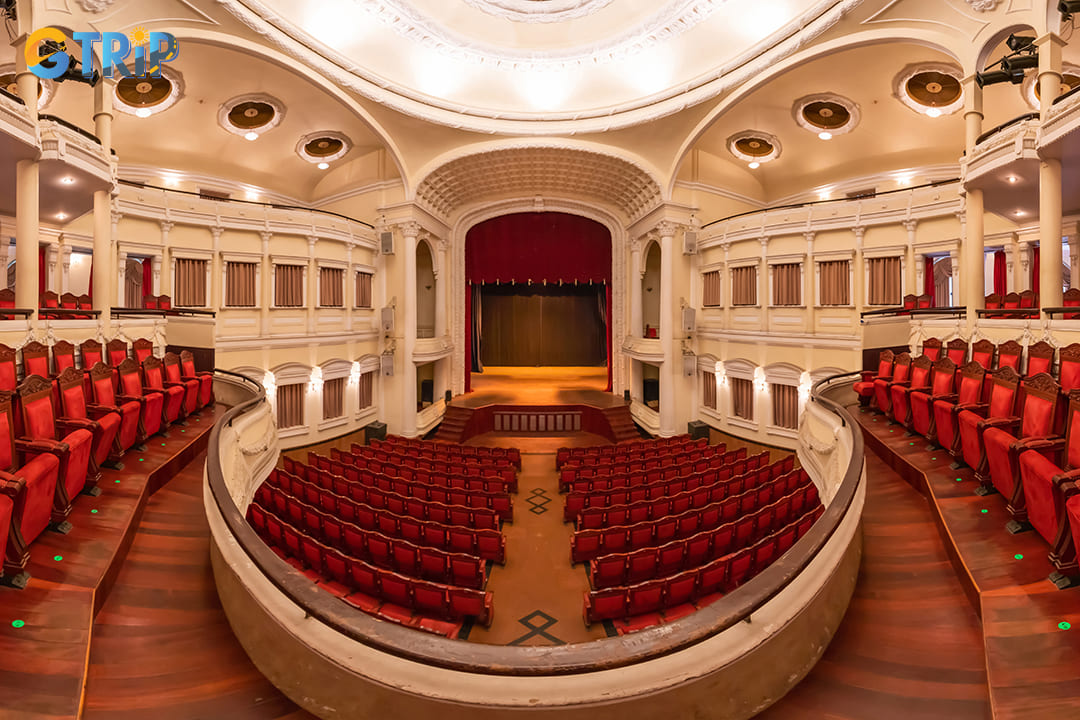
Matching its striking exterior, the opera house’s interior is crafted to offer visitors a fully immersive artistic experience
Top 4 things to do at the Saigon Opera House
While its primary purpose is hosting performances, the Saigon Opera House offers several distinct activities for visitors. Here’s how you can best experience this iconic landmark.
1. Attend a signature performance
This is the essential experience at the Saigon Opera House, offering a rich cultural journey with a variety of performances, from classical ballet and symphonic concerts to contemporary dance and traditional Vietnamese arts. Signature shows include globally acclaimed ballets like Swan Lake and The Nutcracker, as well as A O Show, The Mist, and Teh Dar Show, which blend contemporary dance with Vietnamese storytelling.
The venue also preserves Vietnam’s heritage through traditional arts like cai luong (Southern folk opera) and cheo (Northern folk theatre), and hosts annual festivals such as Autumn Melody featuring local and international artists. Prominent musicians and troupes, including the Ho Chi Minh City Ballet Symphony Orchestra and Opera (HBSO), perform regularly, presenting works by legends like Beethoven, Mozart, and Tchaikovsky for a diverse and memorable program.
- Key shows: Prioritize booking tickets for the A O Show, The Mist, or Teh Dar Show, as they are designed to captivate international audiences.
- How to book: Check the official schedule on the Lune Production website and book tickets online in advance to secure your seats.
- Tips: For the latest schedule and ticket information, refer to the official website or social media pages of the Saigon Opera House.
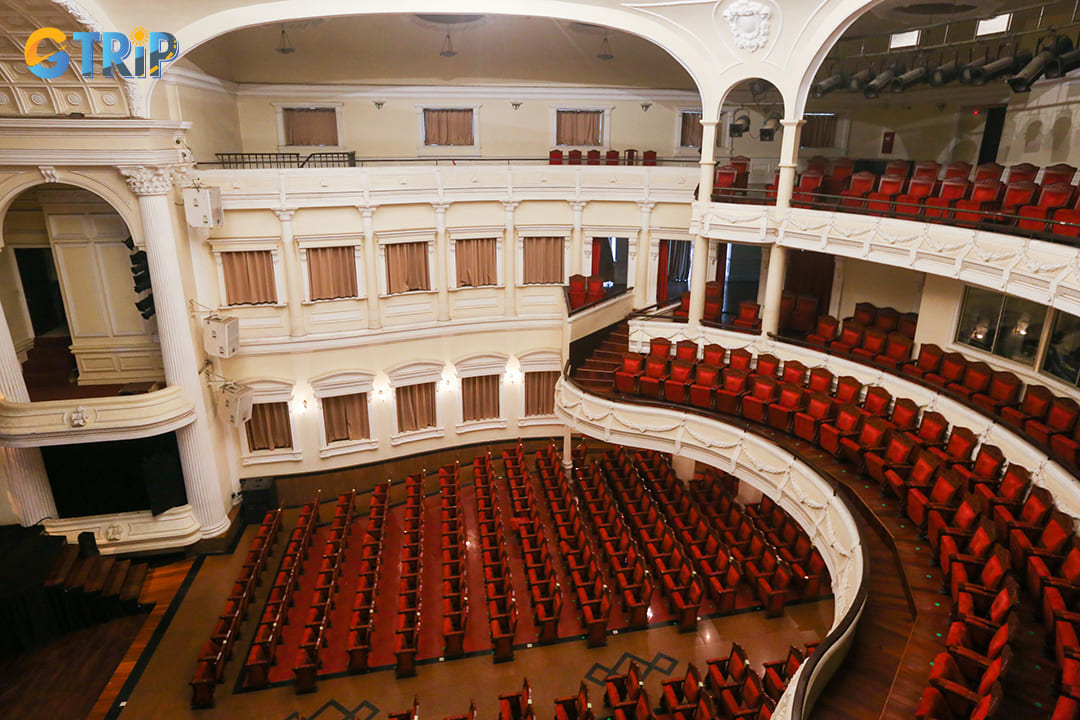
A visit to the Ho Chi Minh City Opera House offers a captivating cultural experience with a diverse lineup of performances
2. Explore the French colonial architecture
The Saigon Opera House is a living museum of French colonial architecture in Vietnam. Even without a ticket to a show, visitors spend time admiring its stunning exterior, which was modeled after the Petit Palais in Paris.
- What to look for: Pay close attention to the ornate facade, the statues of the Greek goddesses on the entrance arch, and the intricate stone-carved reliefs.
- Historical context: The building was completed in 1897 and has served various purposes throughout history, including being the Lower House Assembly of South Vietnam.
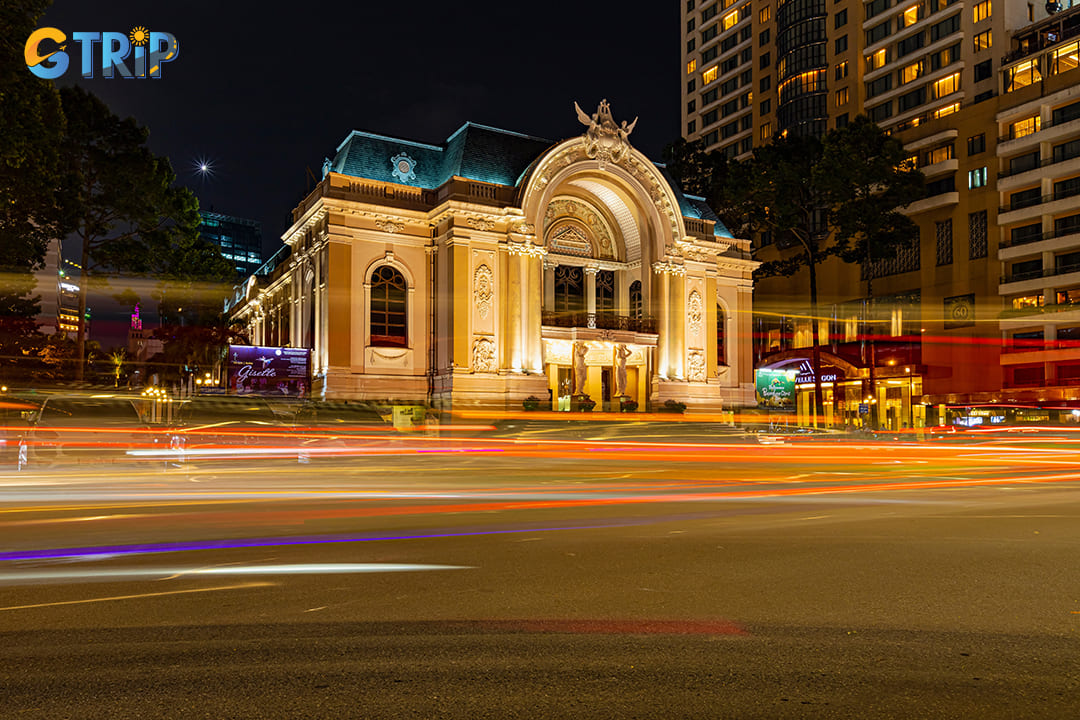
As the sun sets, the Ho Chi Minh City Opera House transforms into a breathtaking spectacle
3. Capture iconic photos of the landmark
The Saigon Opera House is one of Ho Chi Minh City’s most photographed buildings, favored for its perfect symmetry and grand presence. To get the best shots, consider both your location and the time of day.
- Best photography spots:
- Lam Son Square: The classic choice for a direct, full-frontal shot that captures the building's entire facade.
- Caravelle Saigon Hotel: Head to a higher floor or the rooftop bar for an elevated perspective away from the street-level crowds.
- Dong Khoi Street: Stand further down the street to create a compelling composition that contrasts the colonial Saigon Opera House with the modern city skyline behind it.
- Best times to photograph:
- Daytime: The soft morning light is ideal for highlighting the intricate architectural details, sculptures, and reliefs on the facade without harsh shadows.
- Nighttime: After sunset, the entire building is illuminated by warm, golden lights, creating a spectacular and romantic scene. This is perfect for long-exposure shots to capture light trails from passing traffic.
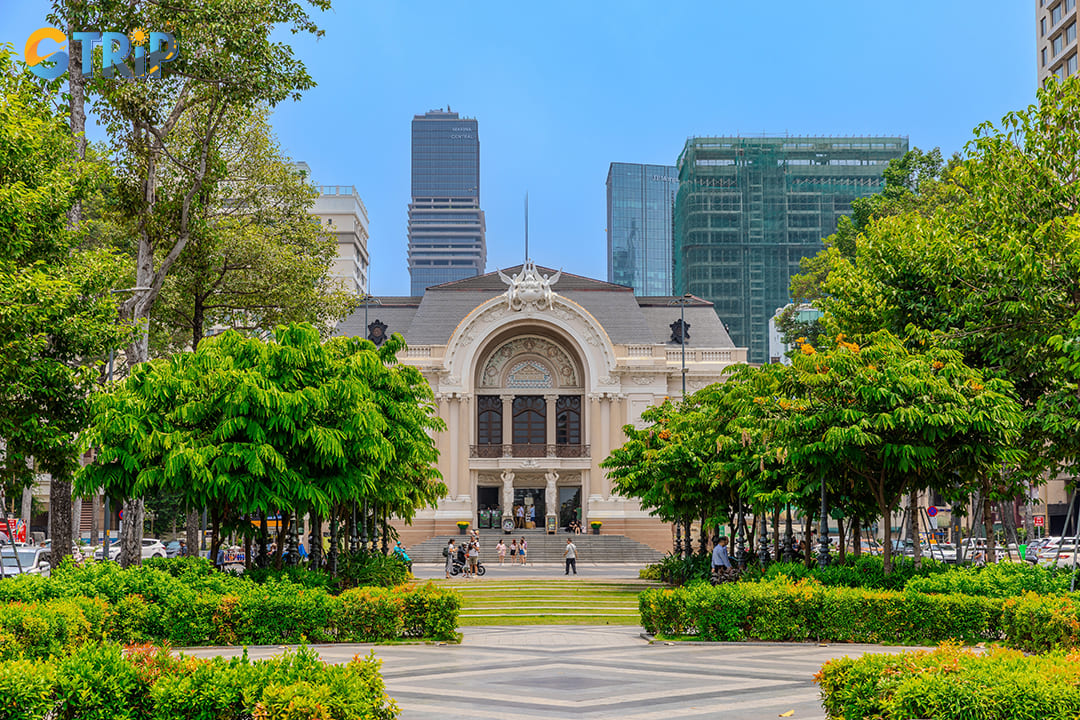
The building is best captured in the morning or late afternoon when natural light highlights its ornate exterior without casting harsh shadows
4. Experience Saigon's unique coffee culture
The area around the Opera House offers two contrasting yet equally iconic Saigon coffee experiences: the luxurious rooftop view and the authentic street-level buzz.
- For a luxurious view (rooftop cafes): Head to the rooftop bars at historic hotels like the Caravelle Saigon or Hotel Continental Saigon. From here, you can enjoy a cocktail or coffee with a classic, unobstructed view of the Opera House and Lam Son Square, soaking in the colonial-era elegance.
- For an authentic local vibe (sidewalk coffee): Join the locals right on the pavement for a true taste of Saigon. Grab a classic iced milk coffee from a street vendor and find a spot on the low plastic stools (or even just a newspaper) on the side of the Opera House. It's not about comfort; it's about immersing yourself in the city's vibrant, raw energy.
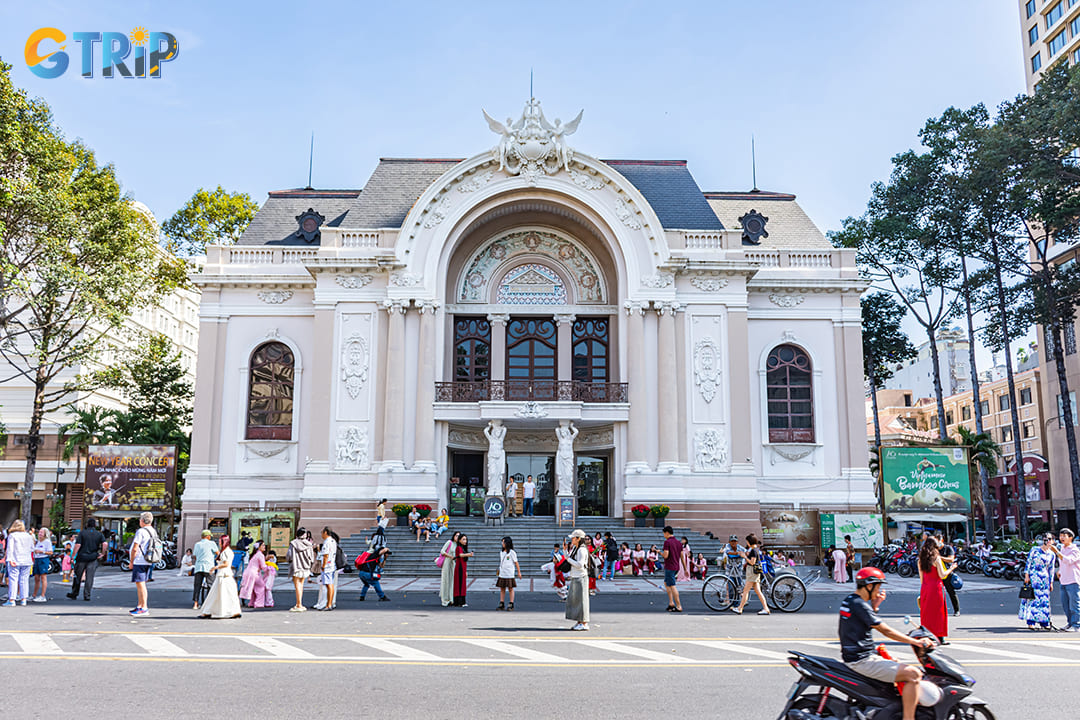
Savor Saigon coffee from a rooftop or join locals at sidewalk cafes by the Opera House
Nearby attractions to visit from Saigon Opera House
The opera house is centrally located in former District 1, making it easy to explore nearby attractions. Below are some attractions that we recommend to tourists:
Saigon Central Post Office (550 m)
Located just a short stroll from the Saigon Opera House, the Saigon Central Post Office stands as a quintessential example of French colonial architecture. Designed by the renowned Gustave Eiffel, its construction was completed in 1891. The post office not only functions as a postal service hub but also serves as a popular tourist destination.
Inside, you can marvel at the vaulted ceilings and period details, which include intricately designed tiles and a giant portrait of Ho Chi Minh. The elegant interiors are contrasted by bustling activity as locals and tourists alike come to send postcards or simply explore. Among the standout features are the historic phone booths and old maps of Saigon on display, offering a glimpse into the city’s past. This iconic landmark provides not just postal services but a cultural experience, making it a must-visit for those touring the city.
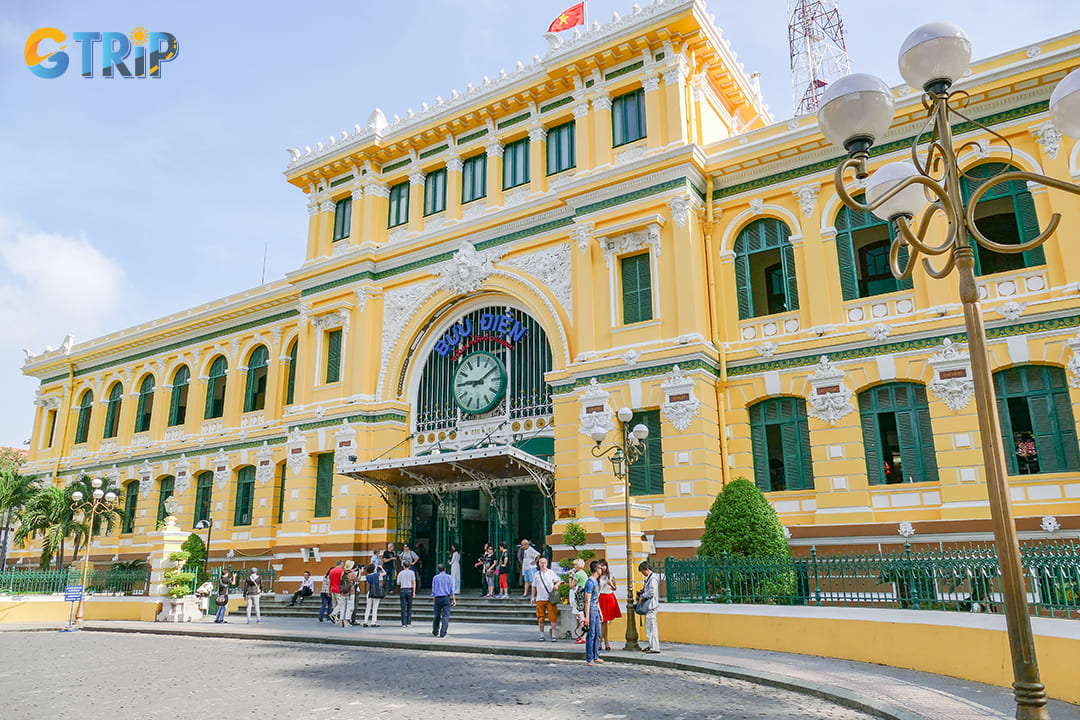
The Saigon Central Post Office stands as a quintessential example of French colonial architecture
Saigon's Notre Dame Cathedral (500 m)
A mere five-minute walk from the opera house brings you to another significant symbol of Saigon’s colonial history, the Saigon's Notre Dame Cathedral. Constructed between 1863 and 1880 by French colonists, the cathedral's neo-Romanesque architecture is a striking sight amidst the modern cityscape.
Characterized by its distinctive red brick facade, which was imported directly from France, the cathedral features two prominent bell towers reaching a height of 58 meters. Inside, the serene atmosphere, stained glass windows, and religious artifacts offer you a peaceful retreat from the city's hustle. Masses are still conducted here, and participants can experience the deep-rooted Catholic traditions in Vietnam. The cathedral offers a serene and historical complement to your exploration of the opera house area.
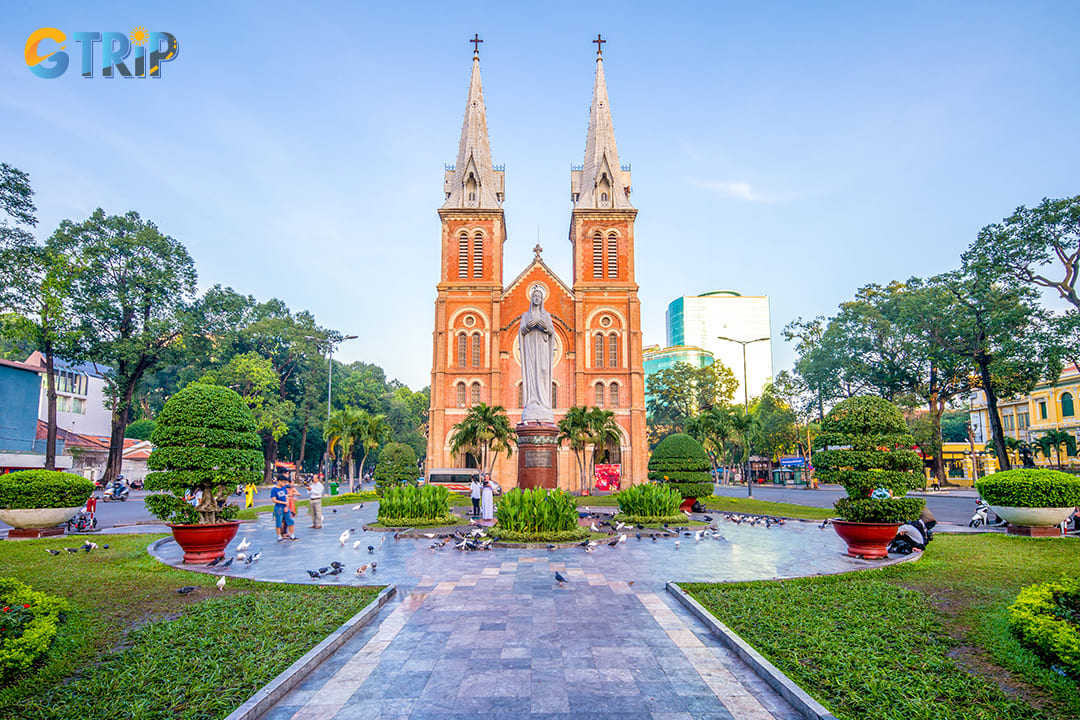
A significant symbol of Saigon’s colonial history is the Notre Dame Cathedral of Saigon
Best dining and food options near the Ho Chi Minh City Opera House
The area surrounding the Ho Chi Minh City Opera House offers a wide array of dining options, ranging from upscale restaurants to casual street food stalls. Here are some popular and reliable spots to consider when exploring the area.
Fine dining restaurants
For those seeking an elegant dining experience, several high-end restaurants near the opera house provide top-quality meals in chic settings:
- Square One (Park Hyatt Saigon): A luxurious dining spot offering a mix of Vietnamese and Western cuisine. Square One is celebrated for its superb service and elegant ambiance.
- El Gaucho Argentinian Steakhouse: A renowned spot for high-quality steaks and an extensive wine list. It’s one of the best places for steak lovers in Ho Chi Minh City.
Authentic Vietnamese cuisine
To enjoy true Vietnamese flavors, you don’t have to go far from the opera house. Here are a few reliable spots to try local favorites:
- Quan An Ngon: Offering a vast selection of traditional Vietnamese street food in a comfortable setting, this restaurant is a local favorite for a good reason.
- Pho Hoa Pasteur: A beloved pho restaurant that has been serving delicious, rich bowls of Vietnamese noodle soup for decades. A perfect place for pho enthusiasts.
- Huong Lai Restaurant: An ideal destination for classic Vietnamese dishes, this restaurant also supports local communities by providing employment to disadvantaged groups.
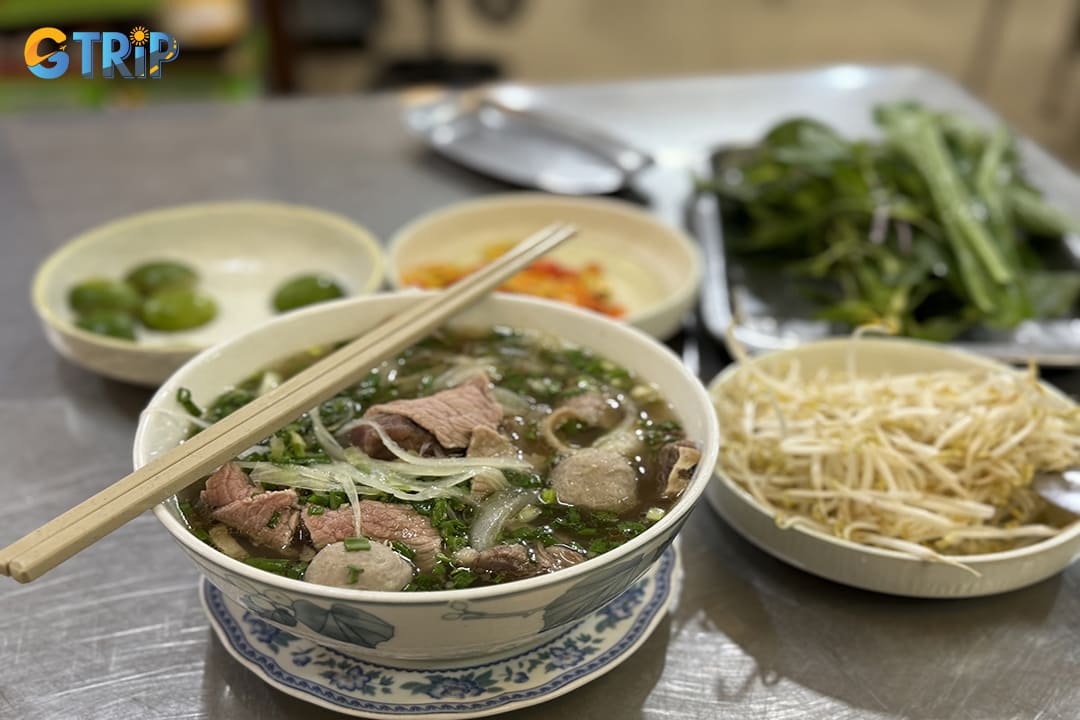
Pho Hoa Pasteur is a beloved pho restaurant that has been serving delicious, rich bowls of Vietnamese noodle soup for decades
Casual cafes and bakeries
For a more relaxed dining experience or a quick coffee break, consider these well-loved cafés and bakeries:
- Cafe Runam D'Or: A stylish cafe offering both Vietnamese and Western-style coffee, pastries, and light bites. It’s an excellent spot for enjoying a leisurely coffee break.
- Maison Marou Saigon: A must-visit for chocolate lovers, Maison Marou is a popular chocolate shop offering handmade chocolate, desserts, and drinks.
- The Workshop Coffee: Known for its artisanal coffee and stylish atmosphere, this specialty cafe is perfect for coffee connoisseurs.
Street food stalls
If you’re looking to indulge in Ho Chi Minh City’s street food culture, there are plenty of tasty options near the opera house:
- Banh mi Huynh Hoa: Famous for its delicious and fresh banh mi (Vietnamese sandwich), this vendor is an iconic stop for anyone wanting to taste one of Vietnam’s most famous street foods.
- Goi cuon Ma Toi: Known for fresh and tasty goi cuon (Vietnamese spring rolls), this stall offers a great snack to enjoy while exploring the area. Their rolls are filled with shrimp, pork, and fresh vegetables, providing a healthy and delicious option.
- Banh xeo 46A: A popular stall that specializes in banh xeo (Vietnamese crispy pancakes) served with fresh herbs, lettuce, and dipping sauces. It's an authentic Vietnamese street food experience that’s sure to impress.
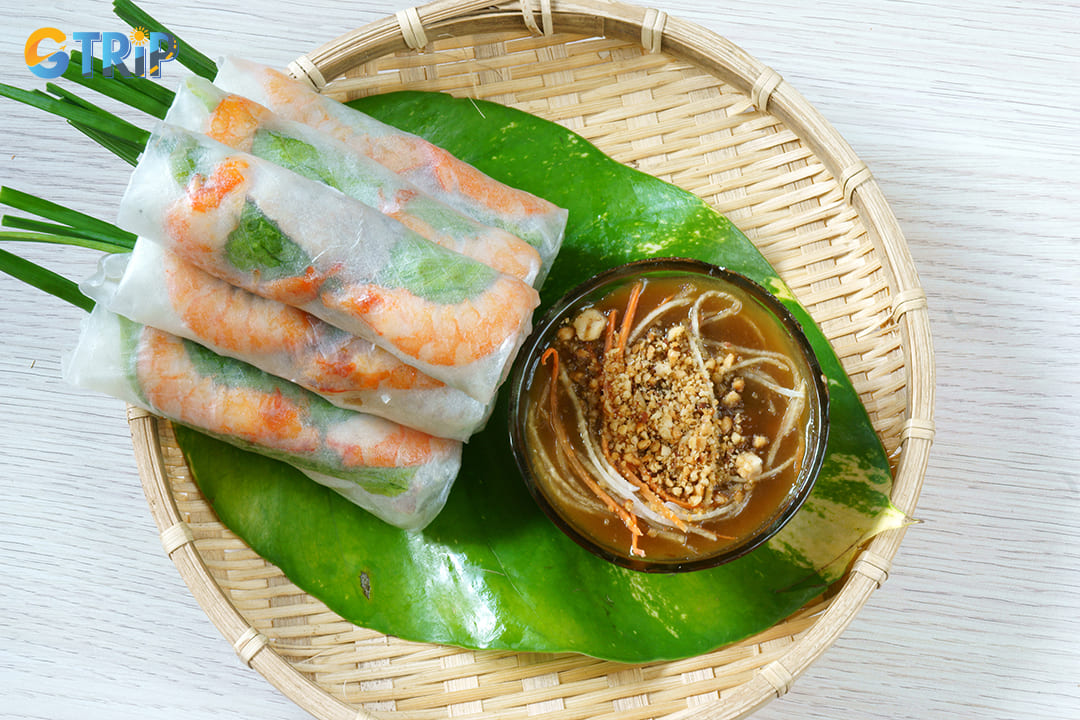
Goi cuon rolls are filled with shrimp, pork, and fresh vegetables, providing a healthy and delicious option
Frequently asked questions about Saigon Opera House
Visiting the Saigon Opera House can be an exciting and enriching experience, and many tourists have common questions regarding attendance, tours, and venue policies. Below are answers to some frequently asked questions to help you prepare for your visit.
Is there a dress code for attending performances?
While there is no strict dress code, it is generally recommended to wear smart casual attire when attending performances. Avoiding overly casual clothing such as flip-flops and shorts is advisable to align with the venue's ambiance.
Are guided tours available?
Guided tours are not regularly scheduled but may be available during specific events or by prior arrangement. To inquire about the possibility of a guided tour, it is best to contact the Opera House directly or consult with local tour operators.
Is photography allowed inside the Saigon Opera House?
Photography policies can vary depending on the event and production company. Generally, flash photography and recording during performances are prohibited to avoid disturbing performers and other audience members. It's advisable to check with the venue staff or event organizers regarding specific photography guidelines.
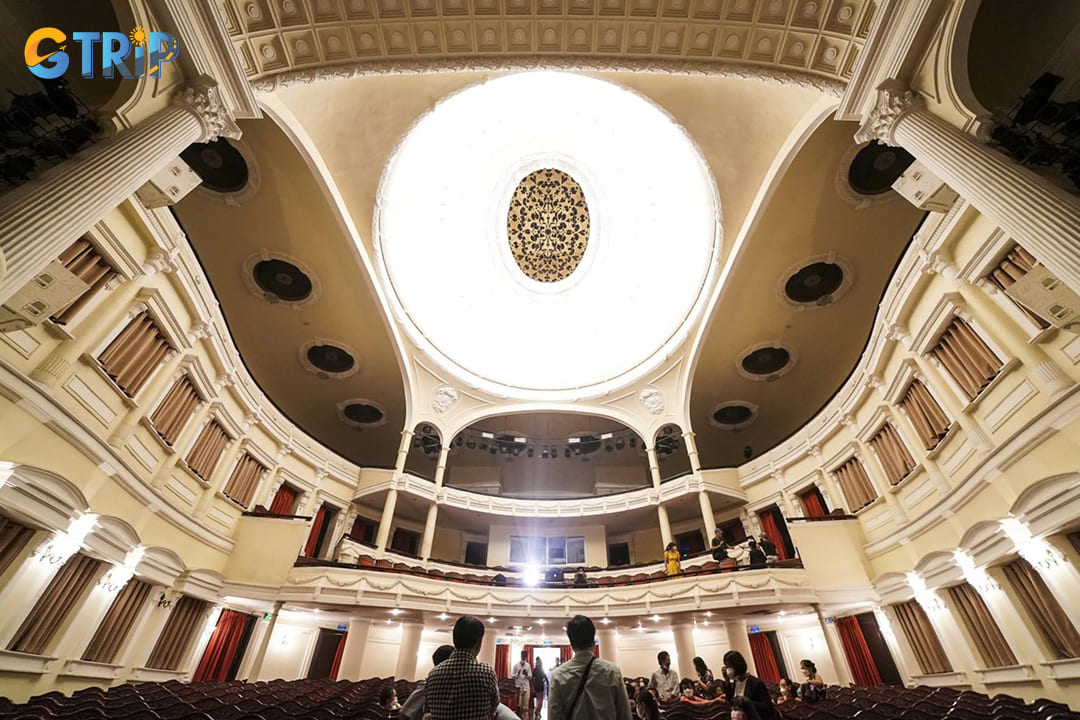
Photography policies can vary depending on the event and production company
For a seamless way to explore the city, you can book GTrip’s Ho Chi Minh City 1-Day Tour & Dinner Cruise, which features a visit to the Saigon Opera House along with other must-see landmarks before ending the day with a scenic river cruise dinner.
The Saigon Opera House, also known as the Ho Chi Minh City Opera House, stands as a historical and cultural landmark. It showcases exquisite French colonial architecture while serving as a premier venue for opera, ballet, and artistic performances. Its preservation and ongoing use highlight the city's dedication to cultural heritage and contemporary arts. You can stay informed about events through the official website, cultural event calendars, social media, and local publications. For those planning Ho Chi Minh City Tours, GTrip - Vietnam Travel Agency offers great options to explore the Opera House and many other attractions.

